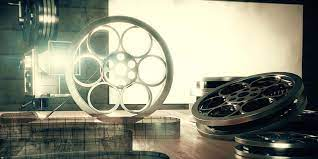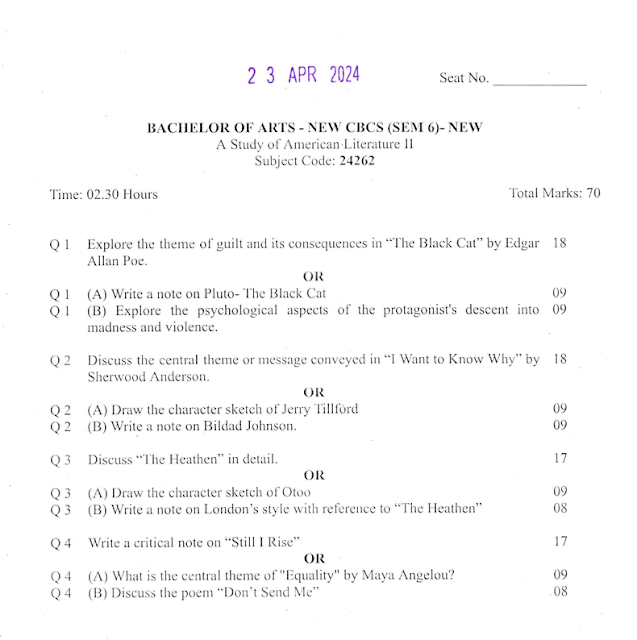Academic Information
Name: Rajeshvariba Rana
Roll No: 16
Semester: 3 (Batch 2022-24)
Enrolment number: 4069206420220023
Paper No: 204
Paper name: Contemporary Western Theories and Film Studies
Paper code: 22409
Topic: "A Journey into Educational Innovation with Literature and Film"
Submitted to: Smt. S.B. Gardi, Department of English, MKBU
Email Address: rhrana148@gmail.com
Submission Date: 27th Nov 2023
"A Journey into Educational Innovation with Literature and Film"
Introduction:
Film studies is an academic field that explores diverse theoretical, historical, and critical perspectives on cinema as both an artistic expression and a medium. While occasionally incorporated into media studies, it is frequently juxtaposed with television studies.
Film studies is less concerned with advancing proficiency in film production than it is with exploring the narrative, artistic, cultural, economic, and political implications of the cinema.
Learning is a powerful tool and a guiding light that illuminates the path toward achieving life goals and success. When it comes to subjects, particularly literature, using movies as a medium can be highly engaging and effective. Many researchers argue that authentic videos are more motivating and beneficial compared to traditional textbooks when teaching literature. Movies offer various advantages in the learning process, including vocabulary retention, pronunciation improvement, developing native-like speaking skills, and enhancing the overall learning experience.
As Crose (2013) suggests, "One of the greatest strengths of video is the ability to communicate with viewers on an emotional, as well as a cognitive, level." Additionally, movies play a crucial role in advancing language skills such as reading, listening, and speaking. When students watch movies, they can easily memorize, comprehend, and practice language concepts, retaining the information for a longer duration.
The Dynamic Relationship Between Books and Movies
Books and movies are frequently seen as rival interpretations of the same narrative content. Traditionally, the flow of content from novels to films and plays to movies has been unidirectional – from the more established literary and theatrical forms to the emerging cinematic medium.
Judgment Based on Fidelity:
The evaluation of many movies has historically hinged on their faithfulness to their literary origins, treating books and plays as ideal templates for achieving aesthetic excellence in cinema. Divergences between the literary source and its cinematic adaptation often led to the filmmaker being criticized for insensitivity and perceived infidelity to a supposedly superior art form. Alternatively, the medium itself was given a degree of leniency due to its relative novelty.
Heresy of Improvement:
The notion that a film could enhance or improve upon its source material is still considered somewhat heretical. At most, the argument in favor of cinema generally revolves around the idea that it should strive to establish its unique mode of expression, avoiding contamination from other art forms.
Advocacy for "Pure" Film:
For over half a century, the concept of "pure" film has been advocated, often linked to the belief that film is primarily a visual art, closer to painting and sculpture than to literature. Many proponents of so-called pure cinema have backgrounds in painting, sculpture, or even architecture, as opposed to literary or theatrical arts.
Vachel Lindsay's Vision:
One of the earliest aestheticians of film, American poet Vachel Lindsay, foresaw the eventual evolution of movies from peep shows to esteemed art galleries. Lindsay's writings, filled with references to paintings, and his lectures, typically delivered at art museums, highlighted the intersection between cinema and visual arts.
Vachel Lindsay's Vision and the Early Challenges of Sound in Film
Vachel Lindsay's Perspective:
While Vachel Lindsay was a passionate advocate for Christian virtue and temperance, his views on film were not solely rooted in the pursuit of art for art's sake. Instead, Lindsay envisioned film as a tool for expressive evangelism, fervently believing in its potential to divert the working classes from the social ills associated with alcohol consumption. Like many aestheticians of his time, Lindsay accepted the inherent connection between cinema and literature as an established reality.
The Aesthetic Tension:
From the inception of cinema, a critical tension emerged between its a priori visual nature and its subsequent a posteriori literary applications. The nomenclature itself reflected shifts of emphasis, with terms like "moving pictures" highlighting the pictorialism of painting or photography in motion. In contrast, "photoplay" suggested a play developed through visual rather than verbal images. This tension became more pronounced with the advent of sound, marking a significant shift in the medium.
Impact of Sound on Film Aesthetics:
The introduction of synchronized sound in films, while groundbreaking, created a sense of betrayal within the film industry. Filmmaker Paul Rotha expressed this sentiment in 1929, asserting that films perfectly aligning speech and sound effects with visual images were contrary to the essence of cinema. Rotha argued that such "dialogue films" were degenerate attempts that deviated from the true boundaries of the medium, posing harm to the culture of the public. He contended that their sole aim was financial gain, leading to resentment among discerning audiences and intelligent directors.
The Cinematic Duality: Impurity and Promiscuity
The nature of film is characterized by a dual identity—simultaneously impure and incredibly promiscuous. Its expansive range is tempered by a brief attention span, capable of translating surfaces into essences or, at its worst, indiscriminately devouring the mundane aspects of reality. Film exhibits characteristics akin to various arts—temporal like music, spatial like painting, sensible like literature, and mechanically reproductive like photography. However, it can also absorb these arts literally and unimaginatively.
The Dark Path into Cinematic Forms:
To understand the complexities of cinematic forms, one must delve into the vast array of movies. This journey is marked by darkness, cultural instability, and the treacherous terrain of navigating through various cinematic experiences. The medium poses a peculiar challenge with its potential for a voluptuous passivity beyond belief—an aspect that is both a curse and a cause for minds to become hopelessly muddled.
Literature and Film: Nurturing Minds, Shaping Perspectives
Literature
Fosters Critical Thinking:
Critical thinking is a fundamental skill, and the study of literature provides an ideal platform for its development. Analyzing various elements in literature encourages readers to think critically, concentrating on details, forming opinions, and connecting events within a story. This skill set proves invaluable in enhancing essay-writing abilities, particularly for argumentative essays. Accessing essay samples, such as an "A Rose for Emily" argumentative essay, further aids in honing these skills and contributes to academic success.
Enhances Communication Skills:
Literature plays a pivotal role in improving both speaking and writing skills. Effective communication is crucial not only in academic endeavors but also in daily interactions. Early exposure to literature contributes to the development of excellent communication skills, impacting how individuals engage with others in various aspects of life.
Maintains Brain Health:
Reading literature offers numerous benefits for brain health. It stimulates the mind, promotes imagination, and enhances concentration. Regular mental exercise through reading contributes to overall cognitive health. A healthy and active brain fosters creativity and innovation, making literature a valuable tool for mental well-being.
Film
Effective Teaching Tool in History:
Films serve as powerful teaching aids, particularly in history classes. They provide a visual representation of historical events, aiding learners in understanding and retaining crucial information. The accessibility of films in various genres allows educators to choose movies that align with specific topics, enhancing the learning experience.
Entertainment in Education:
Incorporating films into the educational process adds an entertaining element to lessons. Films, a popular form of entertainment, make classes more exciting and engaging. Traditionally theoretical education can become more dynamic, and students are likely to look forward to attending classes when films are introduced as part of the learning experience.
Beneficial for Autistic Students:
For autistic learners, traditional theoretical teaching methods may lack engagement. Films offer a visually stimulating and emotionally engaging alternative, making it easier for autistic students to comprehend key concepts and actively participate in the learning process.
Promotes Understanding of Society:
Movies often present diverse characters with varying perspectives on the plot. This multifaceted portrayal helps students understand different approaches to handling situations. Watching films in class exposes learners to various scenarios, fostering an appreciation for individual differences and different strategies for navigating life's challenges.
The Transformative Synergy of Literature and Film in Education
In the realm of education, the symbiotic relationship between literature and films stands as a beacon of innovation and engagement. Far removed from the monotony of lengthy lectures, these mediums serve as dynamic tools that not only captivate learners but also facilitate a profound understanding of key concepts. The traditional notion of studying as a dreary and uninteresting endeavor is shattered, replaced by an invigorating approach that kindles curiosity and sparks intellectual exploration.
Conclusion:
The fusion of literature and films in education is a transformative endeavor, breaking the shackles of conventional learning. It propels students into a world where exploration, empathy, and critical thinking converge. Now is the opportune moment for educators to embrace this dynamic duo, cultivating an environment where academic goals are achieved, and a lifelong love for learning is ignited.
Both literature and films offer a refreshing departure from conventional teaching methods, making learning a vibrant and immersive experience. The power of storytelling, whether through the written word or on the cinematic screen, has the ability to capture the imagination of learners, encouraging them to delve into the intricacies of narratives and ideas. This engagement is particularly crucial in an era where attention spans are often challenged, and the need for innovative teaching methods is paramount.
(Word Count 1565; Images 02)
Works Cited
Sarris, Andrew. “Literature and Film.” The Bulletin of the Midwest Modern Language Association, vol. 4, no. 1, 1971, pp. 10–15. JSTOR, https://doi.org/10.2307/1314967. Accessed 22 Nov. 2023.
Hill, W. John, and Pamela Church Gibson, editors. Film Studies: Critical Approaches. Oxford University Press, 2000. Accessed 22 November 2023.




No comments:
Post a Comment